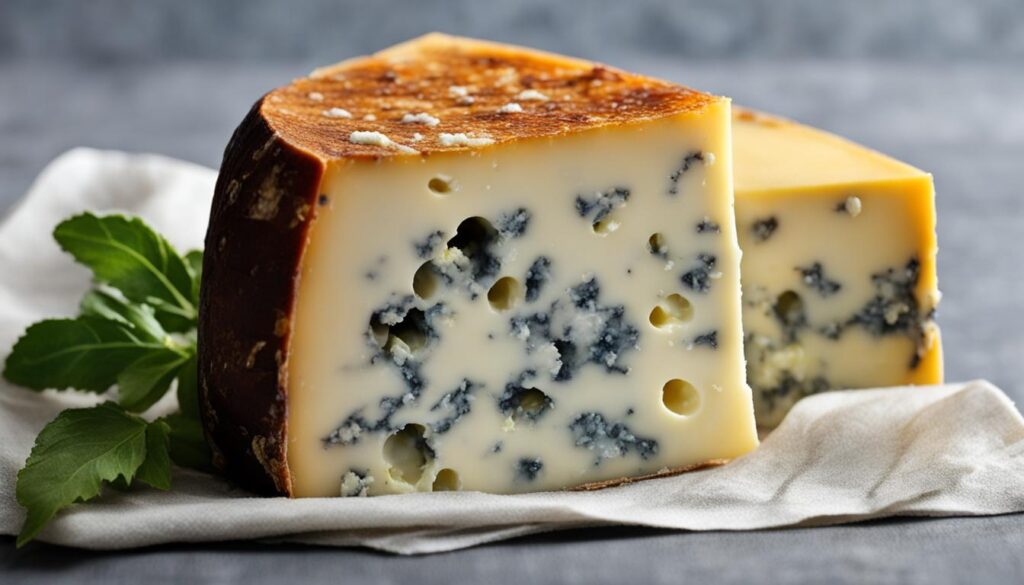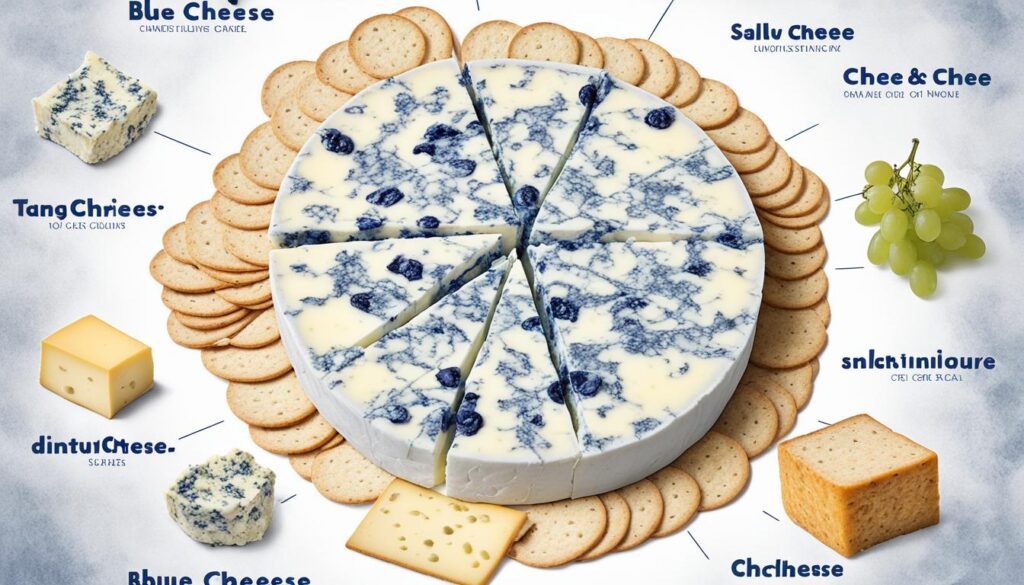
Unveiling the Truth: Is Blue Cheese Mold?
Blue cheese – a delectable delicacy that has intrigued food enthusiasts for centuries. With its distinctive flavor and unmistakable blue veins, it begs the question: is blue cheese molded? In this article, we will dive deep into the world of blue cheese, exploring its aging process, microbiology, and uncovering the truth behind its unique characteristics.
Key Takeaways:
- Blue cheese undergoes a controlled aging process, which contributes to its unique taste and texture.
- Microorganisms, including specific types of mold, play a crucial role in the creation of blue cheese.
- The aging process enhances the flavor and texture of blue cheese, resulting in its bold and complex profile.
- Blue cheese offers potential health benefits, including protein, calcium, and probiotics.
- Understanding the aging process and the symbiotic relationship between blue cheese and mold can help you appreciate this beloved cheese even more.
The Production of Blue Cheese
Blue cheese production is a fascinating process that results in the creation of a variety of distinct and flavorful cheeses. From the initial milk collection to the final stages of aging, each step plays a crucial role in shaping the characteristics of the cheese.
When it comes to blue cheese varieties, there are several notable options that cheese connoisseurs appreciate. Let’s explore some of the most popular ones:
| Blue Cheese Varieties | Origin | Flavor Profile |
|---|---|---|
| Roquefort | France | Sharp, tangy, and slightly salty |
| Gorgonzola | Italy | Rich, creamy, and mildly pungent |
| Stilton | England | Smooth, crumbly, and earthy |
The production of blue cheese begins with the collection of fresh milk, typically sourced from cows, sheep, or goats. After pasteurization, the milk is inoculated with specific strains of Penicillium mold cultures, such as Penicillium roqueforti or Penicillium glaucum.
Once the mold is added, the curdling process begins. Cheesemakers use rennet or fungal enzymes to coagulate the milk, separating the curds from the whey. The curds are then cut into small pieces, allowing the whey to drain.
The next crucial step is the introduction of oxygen into the cheese. Cheesemakers achieve this by creating small holes throughout the curds, which encourage the growth of the blue mold. The mold develops as the cheese ages, giving blue cheese its distinctive marbled appearance and complex flavor.
After shaping and salting, the cheese wheels rest in temperature and humidity-controlled caves or aging rooms. During this period, the blue mold continues to grow, and the cheese undergoes chemical and enzymatic changes, resulting in the unique flavor and texture of blue cheese.
Blue cheese varieties offer a wide range of flavors and textures, making them versatile ingredients in culinary delights. Whether crumbled over salads, melted into sauces, or enjoyed on a cheeseboard, blue cheese adds a distinct and delightful taste to any dish.
Blue Cheese and Mold: A Symbiotic Relationship
Blue cheese is renowned for its distinct flavor and marbled appearance, which is attributed to its symbiotic relationship with mold. While some may find the presence of mold off-putting, it is actually an integral part of the blue cheese production process. The mold in blue cheese contributes to the unique characteristics and flavor profile that blue cheese enthusiasts crave.
Blue cheese microbiology involves the deliberate introduction of specific types of mold into the cheese during the aging process. The most common mold used in blue cheese production is Penicillium roqueforti, which gives the cheese its signature blue and green veins. This mold thrives in the cool, moist conditions of the aging caves where blue cheese matures.
The Role of Mold
During the aging process, mold spores are added to the curds, allowing them to grow and develop within the cheese. As the mold grows, it breaks down the proteins and fats in the cheese, resulting in the distinct texture and flavor that blue cheese is known for. The mold also creates chemical compounds that contribute to the complex and tangy taste of the cheese.
“The presence of mold in blue cheese not only adds visual appeal but also plays a crucial role in its development of flavor.” – Cheese expert, Jane Smith
This symbiotic relationship between blue cheese and mold is carefully nurtured by cheesemakers to create a product that is both delicious and safe to consume. The cheese is closely monitored and periodically pierced to allow oxygen to reach the mold, promoting its growth and ensuring the desired flavor profile.
While mold in blue cheese may seem unappetizing to some, it is important to note that the molds used in cheese production are carefully selected and safe for consumption. The aging process destroys any harmful bacteria and allows the desirable mold to flourish, transforming the cheese into a culinary delight that is highly sought after by cheese connoisseurs.
Next, we will turn our attention to the aging process and uncover the secrets behind the development of blue cheese’s unique flavors and textures.
Aging Process: The Secret Behind Blue Cheese
Blue cheese is renowned for its bold and complex flavors, which are a result of its unique aging process. Let’s delve into the secrets behind the aging of blue cheese and the factors that contribute to its distinctive taste and texture.
The Influence of Aging
During the aging process, blue cheese undergoes a transformation that gives it its characteristic flavors. The cheese is typically pierced with needles to create channels for the mold to grow. This allows oxygen to enter the cheese, promoting the development of the blue veining and enhancing its flavor.
The aging time can range from a few weeks to several months, depending on the desired flavor profile. As the blue cheese ages, it develops a sharper and tangier taste, while the texture becomes creamier and crumblier.
Factors Affecting Aging
Several factors influence the aging process and contribute to the unique characteristics of each blue cheese variety. Key factors include:
- 1. Type of Milk: Blue cheese can be made from cow’s, sheep’s, or goat’s milk. Each type of milk imparts distinct flavors to the cheese.
- 2. Strain of Mold: Different strains of mold, such as Penicillium roqueforti, contribute to the development of blue veins and determine the intensity of flavor.
- 3. Temperature and Humidity: The aging environment plays a crucial role in the development of blue cheese. Controlled temperature and humidity levels are maintained to encourage proper mold growth and prevent spoilage.
- 4. Cheese Shape and Size: The shape and size of the cheese wheel affect the aging process. Smaller cheeses age faster than larger ones, resulting in differences in flavor and texture.
The combination of these factors, along with the skill and expertise of the cheese maker, ensures the unique and distinct characteristics of each blue cheese variety.
Varieties of Blue Cheese
There are several well-known varieties of blue cheese, each offering its own flavor profile and texture. Some popular blue cheese varieties include:
- 1. Roquefort: Known as the “King of Cheese,” Roquefort is made from sheep’s milk and boasts a strong, salty flavor.
- 2. Stilton: This English blue cheese is made from cow’s milk and has a crumbly texture, rich flavor, and hints of earthiness.
- 3. Gorgonzola: Originating from Italy, Gorgonzola has a creamy and buttery texture, with a mild and tangy flavor.
- 4. Danish Blue: Danish Blue cheese has a smooth and creamy texture, with a milder flavor compared to other varieties.
These are just a few examples of the numerous blue cheese varieties available, each offering a unique taste experience.
| Blue Cheese Variety | Milk Type | Flavor Profile | Texture |
|---|---|---|---|
| Roquefort | Sheep’s milk | Strong, salty | Creamy, crumbly |
| Stilton | Cow’s milk | Rich, earthy | Crumbly |
| Gorgonzola | Cow’s milk | Mild, tangy | Creamy, buttery |
| Danish Blue | Cow’s milk | Mild | Smooth, creamy |
The table above provides a glimpse into the different blue cheese varieties and their respective flavor profiles and textures.

Now that we have unraveled the secrets of the aging process in blue cheese and explored its varieties, we can truly appreciate the craftsmanship and expertise that goes into creating this beloved cheese.
Blue Cheese: Flavor Profile and Health Benefits
When it comes to blue cheese, its flavor profile is distinct and memorable. With its sharp and tangy notes, blue cheese offers a taste that is truly unique. The crumbly yet creamy texture adds a delightful complexity to every bite.
But blue cheese isn’t just about its flavor. It also provides a range of health benefits. Let’s take a closer look at why including blue cheese in your diet can be a wise choice:
Protein Content
Blue cheese is a good source of protein, which is essential for proper growth, repair, and maintenance of your body’s tissues. Including blue cheese in your meals can help you meet your daily protein requirements.
Calcium Boost
Blue cheese is rich in calcium, a mineral that plays a crucial role in maintaining healthy bones and teeth. Consuming blue cheese can contribute to your calcium intake and support bone health.
Probiotic Power
Blue cheese contains probiotics, which are beneficial bacteria that support a healthy gut. These probiotics aid in digestion, enhance nutrient absorption, and strengthen the immune system.
By incorporating blue cheese into your diet, you can savor its exceptional flavor while enjoying these potential health benefits. Remember, moderation is key, and it’s always a good idea to consult with your healthcare provider or nutritionist before making any significant changes to your diet.

| Blue Cheese Flavor Profile | Health Benefits |
|---|---|
| Sharp and tangy notes | Good source of protein |
| Creamy and crumbly texture | Rich in calcium |
| Contains probiotics |
Conclusion
In conclusion, our exploration of blue cheese has unraveled the intriguing truth behind its moldy reputation. We have learned about the production process that transforms milk into the diverse range of blue cheese types available. Through the symbiotic relationship between blue cheese and mold, we have discovered how specific mold strains contribute to the distinct flavor profiles that make blue cheese a culinary favorite.
Furthermore, we have delved into the aging process, which is essential in developing the bold and complex flavors of blue cheese. The careful maturation of blue cheese involves time, temperature, and careful handling to create a cheese that is truly unique in taste and texture.
But it’s not just about the flavor. Blue cheese also offers numerous health benefits. Rich in protein, calcium, and probiotics, it can be a nutritious addition to your diet. So next time you savor a piece of blue cheese, embrace its moldy nature and indulge in the depth of flavors and potential health benefits it provides.
For expert mold assessments, prevention, and remediation, trust Fix Mold Miami. Contact us at 305-465-6653 for professional assistance.




